SERVICE TO THE POOR
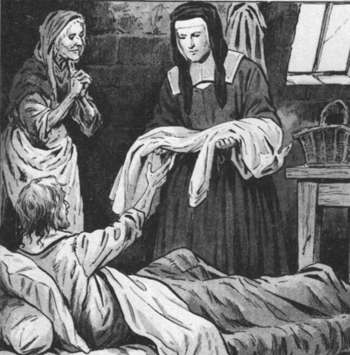 Through Louise’s frequent contacts with Vincent, she gradually immersed herself in the work of the Confraternities and Ladies of Charity. The Confraternities had been established by Vincent in 1617 and their work was focused on organizing people in parishes to help alleviate the misery of needy parishioners. One principle guided them: The poor are Jesus Christ. Vincent required that the personal service given be compassionate, gentle, respectful, devoted and from the heart. The Ladies of Charity was a coalition of wealthy women, mostly from the nobility, serving poor people through their time and money.
Through Louise’s frequent contacts with Vincent, she gradually immersed herself in the work of the Confraternities and Ladies of Charity. The Confraternities had been established by Vincent in 1617 and their work was focused on organizing people in parishes to help alleviate the misery of needy parishioners. One principle guided them: The poor are Jesus Christ. Vincent required that the personal service given be compassionate, gentle, respectful, devoted and from the heart. The Ladies of Charity was a coalition of wealthy women, mostly from the nobility, serving poor people through their time and money.
As Vincent and Louise worked as a team, they discovered and appreciated their complementarity. Vincent and Louise combined daring initiative with prudent planning and constancy. Vincent provided the original vision of service to the poor shaped by the love of Jesus Christ. Louise helped transform that vision into a reality. As God led Louise to the poor, charity burned in her heart so that she found and treasured Christ in the broken hearts, spirits and bodies of the destitute people she served.
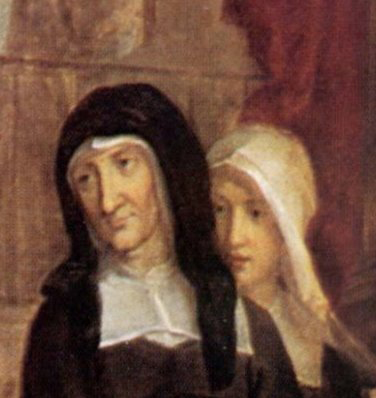 CO-FOUNDRESS
CO-FOUNDRESS
While Vincent was preaching a mission in 1630, a peasant woman of about thirty-two years of age named Marguerite Naseau came to him asking to serve poor people. So, he sent her to Louise who directed her to work with the Ladies of Charity in the Parish of Saint Sauveur in Paris. Marguerite’s example was contagious and soon other young women came. Louise knew that these young women would need a strong formation, rooted in prayer, in order to persevere in their service. It would be by faith alone that they would find God in the poor and the poor in God. She was convinced that a community dedicated to the service of poor, abandoned, orphaned, sick and illiterate people had to be formed.
So, on November 29, 1633, the Company of the Daughters of Charity was born. Without consciously doing so, the Daughters dramatically changed religious life because up to this point, religious communities of women had been confined to cloistered convents. Vincent spoke thus of the Daughters’ way of life:
“Having for their convent the houses of the sick…for a cell a hired room…for a chapel their parish church…for a cloister the streets of the city…for enclosure, obedience…with an obligation to go nowhere but to the houses of the sick, or places that are necessary to serve them…for a grille, the fear of God…for veil, holy modesty…making use of no other form of profession to assure their vocation than the continual confidence they have in divine providence and the offering they make to God of all that they are and of their service in the person of the poor.”
The Daughters of Charity was a community of laywomen. In the early days of the community, they did not take vows but later they began taking simple and private vows for one year at a time.
YEARS OF NEW FOUNDATIONS AND INNOVATIVE SERVICE
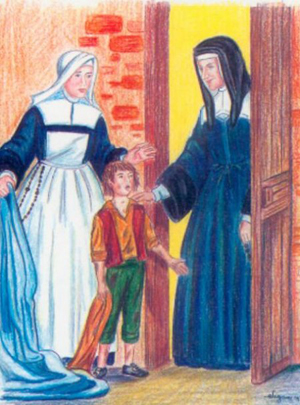 The Foundlings
The Foundlings
In 17th century Paris, an estimated 300 to 400 infants were abandoned each year in the streets or under the porches of churches. These babies were brought to an institution called La Couche to be fed and reared. But the wet nurses and staff were few so the children were given drugs to keep them from crying at night. Some children were also sold to beggars who broke the infants’ arms and legs so they would extract more pity from passersby.
In 1638, Louise organized the Ladies and Daughters to take proper care of these orphans. It became their central work.
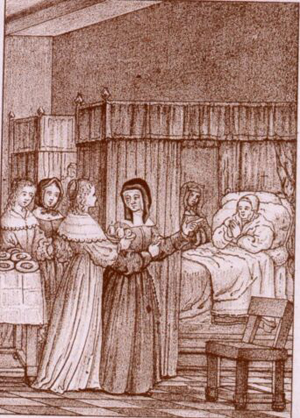 Hospitals
Hospitals
At the Hôtel-Dieu in Paris, 1,200 sick, poor people were forced to sleep several to a bed because of shortage of space. The epidemics that frequented Paris taxed the hospital beyond its capacity and supplies were always lacking.
In 1634, the Ladies and Daughters began ministering and reforming the Hôtel-Dieu, being cordial and patient with the poor people. Five years later, Louise negotiated for the administration of the Hospital Saint Jean in Angers. The conditions were so bad in this hospital that the poor avoided it unless they were dragged there bodily.
The ministry in these first two hospitals established a tradition of hospital ministry that continues today.
The Galley Slaves
The king of France had appointed Vincent de Paul to be chaplain of the galley slaves. Galleys were long, narrow, low-slung boats that were propelled by oar and sail. Convicts, wearing heavy chains, suffering from hunger, fevers, vermin and lack of adequate clothing, were pressed into rowing these boats.
In 1640, the Daughters started ministering to these outcasts: cook their food; wash, mend and replace their clothes; air and clean their cells; clean and treat their sores.
Louise knew that the work with the galley slaves could be dangerous and repugnant and so she admonished the sisters to:
“never reproach them nor speak rudely to them…treat them with great compassion…not to make matters worse by showing favoritism to any prisoner, listening to pleas for help in escaping, ignoring any prison rules…”
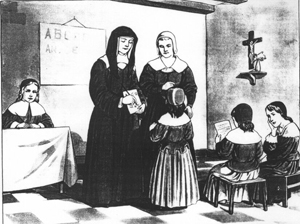
Little Schools
In 1641, Louise inaugurated free schools for the poor little girls of Paris. She also sent the Daughters into homes and even farm fields to teach the children who were needed to help at home or work on the farm. At the same time, she was also teaching the sisters, many of whom were illiterate. Louise taught them reading, basic knowledge of religion, simple arithmetic, writing as well as instruction on the duties of a good Christian woman.
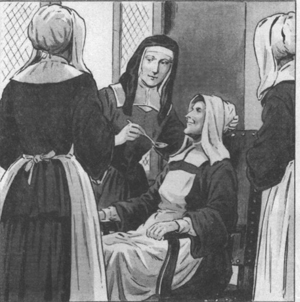 The Elderly Poor
The Elderly Poor
In 1653, Louise organized the Hospice of the Holy Name of Jesus, a home for poor, elderly people. Each person worked according to his or her strength and ability: men wove and made shoes; women made gloves and lingerie. The work mitigated the residents’ loneliness, provided for their maintenance and gave them a sense of dignity.
LAST YEARS
Years of chronic illness and hard work finally brought Louise to her death on March 15, 1660. Louise de Marillac’s legacy to her sisters sums up her life:
Ministry: “Take good care of the poor.”
Community: “Above all, live together in great union and cordiality.”
Prayer: “I continue to ask God for His blessings…Pray earnestly to the Blessed Virgin that she may be your only Mother.”
Love of Christ urged her to go to the poor, the sick, the oppressed, the downtrodden, the imprisoned, the uneducated and the underprivileged. The poor did not lead Louise to God. Jesus led her to the poor. Hence, her motto for the Daughters was: “The charity of Christ urges us.”
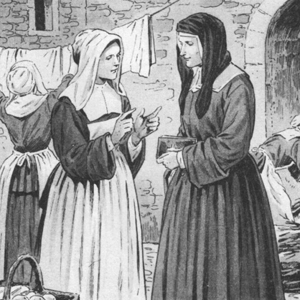 LOUISE FOR TODAY
LOUISE FOR TODAY
Like Louise, we experience a fragmented world, a world filled with confusions and contradictions, a world of suffering, frustrations, difficulties, deceit, pessimism, injustice, futility and loneliness.
Louise welcomed the grace of God, which transformed her fretful heart into a courageous, generous and compassionate heart that loved intensely. She offers us the courage to face ourselves squarely, to overcome our insecurities and our inadequacies, to band together with Christ, and bring healing and hope to our broken world.

